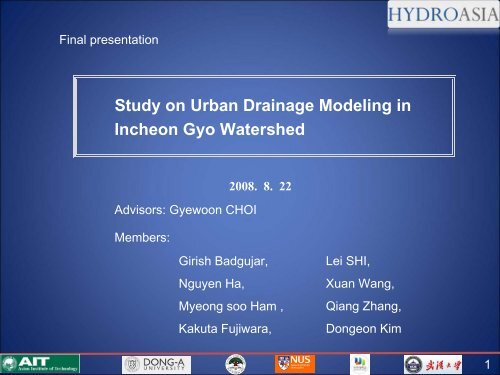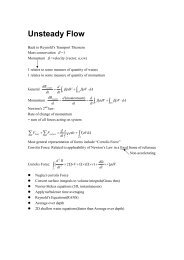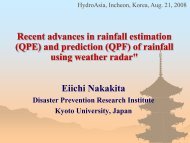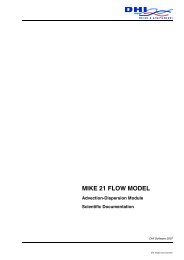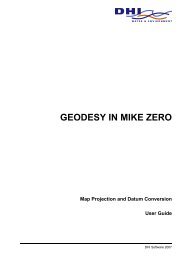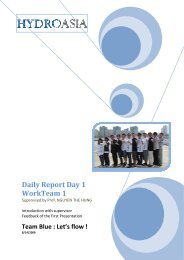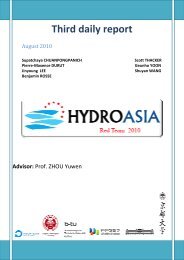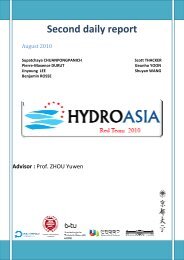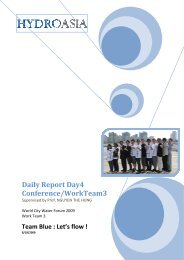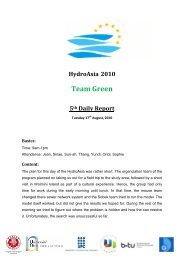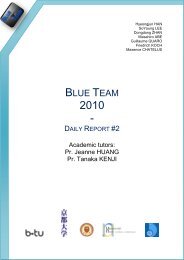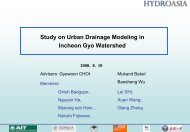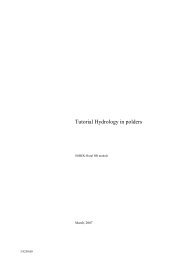Study on Urban Drainage Modeling in Incheon Gyo ... - HydroAsia
Study on Urban Drainage Modeling in Incheon Gyo ... - HydroAsia
Study on Urban Drainage Modeling in Incheon Gyo ... - HydroAsia
You also want an ePaper? Increase the reach of your titles
YUMPU automatically turns print PDFs into web optimized ePapers that Google loves.
F<strong>in</strong>al presentati<strong>on</strong><br />
<str<strong>on</strong>g>Study</str<strong>on</strong>g> <strong>on</strong> <strong>Urban</strong> <strong>Dra<strong>in</strong>age</strong> <strong>Model<strong>in</strong>g</strong> <strong>in</strong><br />
Inche<strong>on</strong> <strong>Gyo</strong> Watershed<br />
Advisors: Gyewo<strong>on</strong> CHOI<br />
Members:<br />
2008. 8. 22<br />
Girish Badgujar,<br />
Nguyen Ha,<br />
Mye<strong>on</strong>g soo Ham ,<br />
Kakuta Fujiwara,<br />
Lei SHI,<br />
Xuan Wang,<br />
Qiang Zhang,<br />
D<strong>on</strong>ge<strong>on</strong> Kim<br />
1
C<strong>on</strong>tent –Team Blue<br />
1. Introducti<strong>on</strong><br />
2. Work Flow for Team Blue<br />
3. <strong>Model<strong>in</strong>g</strong> of Inche<strong>on</strong> <strong>Gyo</strong> Watershed<br />
4. Analysis of the <strong>Model<strong>in</strong>g</strong> Result<br />
5. C<strong>on</strong>clusi<strong>on</strong><br />
2
1. Introducti<strong>on</strong><br />
Youngj<strong>on</strong>g<br />
Airport<br />
Yellow sea<br />
S<strong>on</strong>gdo<br />
Seoul<br />
• Located <strong>in</strong> the midwest<br />
Korea pen<strong>in</strong>sula<br />
near Yellow Sea<br />
• With both<br />
<strong>in</strong>ternati<strong>on</strong>al port<br />
and <strong>in</strong>ternati<strong>on</strong>al<br />
airport<br />
• The third biggest<br />
city <strong>in</strong> Korea<br />
• Populati<strong>on</strong> : 2,730<br />
thousand<br />
3
1. Introducti<strong>on</strong> - Recent Floods at Inche<strong>on</strong><br />
Damages<br />
– Flood<strong>in</strong>g <strong>in</strong><br />
1997 to 2001<br />
(except 2000)<br />
–Total 3,318<br />
Houses and<br />
build<strong>in</strong>gs were<br />
flooded <strong>in</strong> 2001<br />
4
1. Introducti<strong>on</strong> - Flood<strong>in</strong>g<br />
Direct damages: Material loss<br />
Indirect damages: Time=$, Traffic, Producti<strong>on</strong>, Diseases<br />
Social c<strong>on</strong>sequences: Decrease of Property value of<br />
flooded areas…<br />
5
1. Introducti<strong>on</strong> - Objectives<br />
Statement of Problem<br />
• Inche<strong>on</strong> City has experienced flood <strong>in</strong> recent years.<br />
• Most of the areas were flooded even with from year 1997 to 2001.<br />
• Hence to overcome flood<strong>in</strong>g situati<strong>on</strong> some technical<br />
recommendati<strong>on</strong>s are needed<br />
Objective of the study<br />
To c<strong>on</strong>struct the model to simulate 1997 year flood c<strong>on</strong>diti<strong>on</strong><br />
To evaluate the exist<strong>in</strong>g sewer system of Inche<strong>on</strong> city<br />
To design and exam<strong>in</strong>e some technical soluti<strong>on</strong> to alleviate the<br />
flood<strong>in</strong>g situati<strong>on</strong><br />
To provide recommendati<strong>on</strong>s for flood alleviati<strong>on</strong>.<br />
6
2. Work Flow for Team Blue<br />
- Water Level<br />
at each node<br />
- L<strong>in</strong>k water<br />
level,<br />
discharge, and<br />
velocity<br />
- Flood extent<br />
and flood<br />
depth, etc.<br />
General Analysis<br />
Data Collecti<strong>on</strong><br />
Analysis of the collected<br />
data<br />
Model Choos<strong>in</strong>g and Setup<br />
Calibrati<strong>on</strong> and Validati<strong>on</strong><br />
of model parameters<br />
Evaluati<strong>on</strong> of the exist<strong>in</strong>g<br />
dra<strong>in</strong>age capacity of the<br />
system<br />
Design and exam<strong>in</strong>e<br />
technical soluti<strong>on</strong>s for flood<br />
alleviati<strong>on</strong><br />
Results and<br />
Recommendati<strong>on</strong>s<br />
- Hydrologic & Hydraulic Data: Ra<strong>in</strong>fall,<br />
ra<strong>in</strong> gauge coord<strong>in</strong>ates, gate and pump<br />
operati<strong>on</strong>, retenti<strong>on</strong> p<strong>on</strong>d c<strong>on</strong>diti<strong>on</strong>, etc.<br />
- Catchment Data: Coord<strong>in</strong>ates, area,<br />
impervious area, populati<strong>on</strong>, time of<br />
c<strong>on</strong>centrati<strong>on</strong>, Length, hydrological losses<br />
for the <strong>in</strong>dividual catchment, Mann<strong>in</strong>g<br />
number, land use type, etc.<br />
- L<strong>in</strong>ks: Material (Mann<strong>in</strong>g number),<br />
l<strong>on</strong>gitud<strong>in</strong>al profile, Cross secti<strong>on</strong> data<br />
(shape, size)<br />
- Nodes: manholes, bas<strong>in</strong>s, outlets,<br />
- Road system, build<strong>in</strong>g system<br />
- Available GIS Digital Map (0bserved<br />
flood <strong>in</strong>undati<strong>on</strong> map, etc.)<br />
7
2. Work Flow for Team Blue<br />
General Analysis of Ra<strong>in</strong>fall Runoff Process for <strong>Urban</strong><br />
watershed<br />
Mark et al, 2004<br />
8
3. <strong>Model<strong>in</strong>g</strong> of Inche<strong>on</strong> <strong>Gyo</strong><br />
Watershed<br />
Approach for model<strong>in</strong>g<br />
• The phenomen<strong>on</strong> of flood could be understood by model<strong>in</strong>g, if we<br />
could represent the reality with some assumpti<strong>on</strong> <strong>in</strong> the model.<br />
• Selecti<strong>on</strong> of Model<br />
Dynamic, User-friendly, Professi<strong>on</strong>al Eng<strong>in</strong>eer<strong>in</strong>g Package<br />
Capabilities like dynamic memory allocati<strong>on</strong> and data structure<br />
It should have produced good applicati<strong>on</strong>s <strong>in</strong> the past<br />
• MOUSE (ma<strong>in</strong>)<br />
MOUSE is advanced, powerful surface runoff, pipe flow<br />
model<strong>in</strong>g package.<br />
It has been used s<strong>in</strong>ce 1970 for urban model<strong>in</strong>g<br />
Capable of simulat<strong>in</strong>g surface flow and pipe flow<br />
•MIKE SWMM (opti<strong>on</strong>al)<br />
MIKE SWMM is a free powerful model but with some limitati<strong>on</strong>s<br />
9
3. <strong>Model<strong>in</strong>g</strong> of Inche<strong>on</strong> <strong>Gyo</strong><br />
Watershed<br />
MOUSE wants follow<strong>in</strong>g data……..<br />
MOUSE will be used here for two purposed<br />
• To produce surface runoff from ra<strong>in</strong>fall<br />
•To produce pipe flow developed from the surface<br />
flow<br />
Data required for MOUSE<br />
Catchment and catchment characteristics for surface flow<br />
Node, L<strong>in</strong>k and hydraulic characteristics for pipe flow<br />
Time series<br />
•Ra<strong>in</strong>fall<br />
• Water level at different outlets<br />
10
3. <strong>Model<strong>in</strong>g</strong> of Inche<strong>on</strong> <strong>Gyo</strong><br />
Watershed<br />
<strong>Dra<strong>in</strong>age</strong> network of Inche<strong>on</strong> <strong>Gyo</strong> Watershed<br />
c<strong>on</strong>structed <strong>in</strong> MOUSE<br />
11
3. <strong>Model<strong>in</strong>g</strong> of Inche<strong>on</strong> <strong>Gyo</strong><br />
Surface Runoff <strong>Model<strong>in</strong>g</strong><br />
Watershed<br />
Runoff was estimated us<strong>in</strong>g Time Area Curve A<br />
The factors affect<strong>in</strong>g runoff process<br />
•Reducti<strong>on</strong> factor<br />
•Average slope<br />
•Time of c<strong>on</strong>centrati<strong>on</strong><br />
•Initial loss<br />
Above factors are depends <strong>on</strong> the follow<strong>in</strong>g catchment characteristics<br />
•Area of the catchment<br />
•Surface cover of the catchment<br />
12
3. <strong>Model<strong>in</strong>g</strong> of Inche<strong>on</strong> <strong>Gyo</strong><br />
Watershed<br />
Assigned different value<br />
Us<strong>in</strong>g the catchment<br />
characteristics<br />
13
3. <strong>Model<strong>in</strong>g</strong> of Inche<strong>on</strong> <strong>Gyo</strong><br />
Watershed<br />
- Land Utilizati<strong>on</strong><br />
Locati<strong>on</strong><br />
Inche<strong>on</strong> <strong>Gyo</strong><br />
Covered<br />
Open<br />
Channel<br />
Sulnam<br />
Hwasu<br />
Left<br />
Right<br />
Subtotal<br />
Total<br />
1,183.6<br />
997.2<br />
2,180.8<br />
910.9<br />
302.8<br />
Residence<br />
734.3<br />
364.8<br />
1,099.1<br />
204.4<br />
161.6<br />
Market<br />
145.9<br />
47.8<br />
193.7<br />
38.4<br />
67.4<br />
Industrial<br />
226.3<br />
353.3<br />
579.6<br />
357.9<br />
61.7<br />
Green<br />
77.1<br />
231.3<br />
308.4<br />
310.2<br />
12.1<br />
Total<br />
3,394.5<br />
(100%)<br />
1,465.1<br />
(43.2%)<br />
299.5<br />
(8.8%)<br />
999.2<br />
(29.4%)<br />
630.7<br />
(18.6%)<br />
• Distributi<strong>on</strong> of Elevati<strong>on</strong><br />
Elevati<strong>on</strong> Range<br />
Less than 5m<br />
5~7m<br />
More than 9m<br />
Total<br />
Area(ha)<br />
20.7<br />
1,102.7<br />
2,271.1<br />
3,394.5<br />
Rate of Compositi<strong>on</strong> (%)<br />
0.6<br />
32.5<br />
66.9<br />
100.0<br />
14
3. <strong>Model<strong>in</strong>g</strong> of Inche<strong>on</strong> <strong>Gyo</strong><br />
Watershed<br />
- Pipe flow computati<strong>on</strong><br />
•Pipe flow starts with <strong>in</strong>flow from<br />
the surface runoff.<br />
•The underground flow is computed<br />
as pipe flow or open channel flow.<br />
•Full form of St Venant equati<strong>on</strong> and<br />
Modified St Venant equati<strong>on</strong><br />
15
3. <strong>Model<strong>in</strong>g</strong> of Inche<strong>on</strong> <strong>Gyo</strong><br />
Watershed<br />
- MOUSE Results<br />
16
3. <strong>Model<strong>in</strong>g</strong> of Inche<strong>on</strong> <strong>Gyo</strong><br />
Watershed<br />
- Calibrati<strong>on</strong>!!!<br />
Why??? :<br />
For the evaluati<strong>on</strong> of the performance of the model<br />
compared preferably aga<strong>in</strong>st measurements<br />
Select<br />
start<strong>in</strong>g<br />
estimate<br />
Run the<br />
model<br />
Compare<br />
computed<br />
&<br />
observed<br />
Ok<br />
?<br />
Ye<br />
s<br />
F<strong>in</strong>ish<br />
No<br />
Improve<br />
estimate<br />
Flow Chart for Calibrati<strong>on</strong><br />
17
3. <strong>Model<strong>in</strong>g</strong> of Inche<strong>on</strong> <strong>Gyo</strong><br />
Watershed<br />
- Calibrati<strong>on</strong> Result for the Flood <strong>in</strong> 1997<br />
Figure: Maximum Flood result at<br />
nodes shown <strong>in</strong> MIKE VIEW for<br />
a storm of 4, Aug. 1997.<br />
Figure: Observed Inundati<strong>on</strong><br />
Map for Year 1997.<br />
18
3. <strong>Model<strong>in</strong>g</strong> of Inche<strong>on</strong> <strong>Gyo</strong> Watershed<br />
- Results from MIKE VIEW for storm <strong>in</strong> year 1997<br />
Figure: Time series flood for a<br />
storm of 4, Aug. 1997 at node<br />
20066<br />
Figure: Water level profile from node<br />
24699 to node 25098 at 03:00 4/8/97.<br />
19
4. Analysis of the <strong>Model<strong>in</strong>g</strong> Result<br />
- C<strong>on</strong>structi<strong>on</strong> of flood <strong>in</strong>undati<strong>on</strong> map<br />
Generati<strong>on</strong> of DEM from c<strong>on</strong>tour level<br />
‣ DEM should be f<strong>in</strong>e for urban area<br />
‣ Size of 1x1 to 5x5 is recommended for urban analysis<br />
DEM can be created by: c<strong>on</strong>tour map or spot elevati<strong>on</strong><br />
Present case DEM of 5x5 m created us<strong>in</strong>g c<strong>on</strong>tour map as a <strong>in</strong>put<br />
MOUSE output was transferred to GIS us<strong>in</strong>g MIKE 11 GIS<br />
Generati<strong>on</strong> of water surface grids<br />
waterlevel =<br />
h1<br />
h<br />
2<br />
h<br />
+ +<br />
d1<br />
d2<br />
d<br />
1<br />
d + d + d<br />
1<br />
2<br />
3<br />
3<br />
3<br />
Flood<br />
= GeneratedW.<br />
S.<br />
−<br />
DEM<br />
20
4. Analysis of the <strong>Model<strong>in</strong>g</strong> Result<br />
- 3-D DEM for Inche<strong>on</strong> <strong>Gyo</strong> Watershed<br />
Fig.DEM for Inche<strong>on</strong> <strong>Gyo</strong><br />
Watershed with Build<strong>in</strong>gs<br />
Fig.DEM for Inche<strong>on</strong> <strong>Gyo</strong><br />
Watershed without Build<strong>in</strong>gs<br />
21
4. Analysis of the <strong>Model<strong>in</strong>g</strong> Result<br />
Comparis<strong>on</strong> of 1997<br />
flood<br />
22
4. Analysis of the <strong>Model<strong>in</strong>g</strong> Result<br />
- SWMM Input Data<br />
RUNOFF<br />
- Ra<strong>in</strong>fall<br />
- Catchment<br />
EXTRAN<br />
- C<strong>on</strong>duits<br />
-Juncti<strong>on</strong>s<br />
- Outfalls<br />
- Boundary c<strong>on</strong>diti<strong>on</strong>s<br />
23
4. Analysis of the <strong>Model<strong>in</strong>g</strong> Result<br />
- SWMM C<strong>on</strong>trol Data<br />
RUNOFF<br />
- Infiltrati<strong>on</strong> Equati<strong>on</strong>: Hort<strong>on</strong><br />
- Simulati<strong>on</strong> length: 24 hours<br />
- Time step: 30sec<br />
EXTRAN<br />
- Ehanced Explicit Soluti<strong>on</strong><br />
- Start time:19970804<br />
- Length:24h<br />
24
4. Analysis of the <strong>Model<strong>in</strong>g</strong> Result<br />
MIKE SWMM Output<br />
The model A<br />
The model B<br />
The runoff output<br />
25
4. Analysis of the <strong>Model<strong>in</strong>g</strong> Result<br />
- Objective 2: Evaluati<strong>on</strong> of Exist<strong>in</strong>g System!!!<br />
Why Evaluati<strong>on</strong>?????<br />
•The C<strong>on</strong>diti<strong>on</strong>s which system can susta<strong>in</strong> without<br />
Be<strong>in</strong>g produc<strong>in</strong>g harm<br />
• Evaluati<strong>on</strong> by subject<strong>in</strong>g precipitati<strong>on</strong>.<br />
•The ra<strong>in</strong>fall <strong>in</strong>tensity for different return period was available, but<br />
how to generate the storms??????<br />
Generati<strong>on</strong> of Precipitati<strong>on</strong> events us<strong>in</strong>g IDF formulae and<br />
“Alternat<strong>in</strong>g block method”<br />
26
4. Analysis of the <strong>Model<strong>in</strong>g</strong> Result<br />
- Objective 2: Evaluati<strong>on</strong> of Exist<strong>in</strong>g System!!!<br />
Generated Ra<strong>in</strong>fall Hyetograph for 5 Year Return Period us<strong>in</strong>g<br />
Ra<strong>in</strong>fall Return Period Formula (IDF) and Alternat<strong>in</strong>g Block Method<br />
Ra<strong>in</strong>fall (mm)<br />
Time (m<strong>in</strong>)<br />
27
4. Analysis of the <strong>Model<strong>in</strong>g</strong> Result<br />
- Objective 2: Evaluati<strong>on</strong> of Exist<strong>in</strong>g System!!!<br />
Evaluati<strong>on</strong> of System with 5 year and 20 year return period 24 hr<br />
storm<br />
5 Year Return Period<br />
20 Year Return Period<br />
Ra<strong>in</strong>fall<br />
Ra<strong>in</strong>fall<br />
28
4. Analysis of the <strong>Model<strong>in</strong>g</strong> Result<br />
- Objective 3 To design and exam<strong>in</strong>e different technical<br />
Scenarios<br />
1. Effect of retenti<strong>on</strong> p<strong>on</strong>d water level <strong>on</strong> the flood<br />
1a. With 25% higher water level<br />
1b. With 25% lower water level<br />
2. Effect of Manhole diameter <strong>on</strong> the flood<br />
3. Effect of Mann<strong>in</strong>g number <strong>on</strong> the flood<br />
29
4. Analysis of the <strong>Model<strong>in</strong>g</strong> Result<br />
- Objective 3 To design and exam<strong>in</strong>e different technical Scenarios<br />
Scenario 1a. Effect of higher water level at retenti<strong>on</strong> p<strong>on</strong>d<br />
30
4. Analysis of the <strong>Model<strong>in</strong>g</strong> Result<br />
- Objective 3 To design and exam<strong>in</strong>e different technical Scenarios<br />
Scenario 1b. Effect of lower water level at retenti<strong>on</strong> p<strong>on</strong>d<br />
31
4. Analysis of the <strong>Model<strong>in</strong>g</strong> Result<br />
- Objective 3 To design and exam<strong>in</strong>e different technical Scenarios<br />
Scenario 2.Effect of Manhole Diameter <strong>on</strong> Flood<br />
32
4. Analysis of the <strong>Model<strong>in</strong>g</strong> Result<br />
- Objective 3 To design and exam<strong>in</strong>e different technical Scenarios<br />
Scenario 3: Effect of Mann<strong>in</strong>g’s Number<br />
33
4. Analysis of the <strong>Model<strong>in</strong>g</strong> Result<br />
- Objective 4: Recommendati<strong>on</strong>s<br />
• From Scenario 1a and 1b: The water level at retenti<strong>on</strong> p<strong>on</strong>d affects<br />
flood<strong>in</strong>g. If retenti<strong>on</strong> p<strong>on</strong>d is ma<strong>in</strong>ta<strong>in</strong>ed at higher water level, more<br />
flood<strong>in</strong>g will occur and vice versa. Hence it is important to limit rise of<br />
water level at the retenti<strong>on</strong> p<strong>on</strong>d.<br />
By <strong>in</strong>creas<strong>in</strong>g the p<strong>on</strong>d volume (p<strong>on</strong>d expansi<strong>on</strong> is not possible<br />
because of exist<strong>in</strong>g <strong>in</strong>frastructure, hence dredg<strong>in</strong>g is necessary<br />
Introduce high capacity Pump to discharge water quickly <strong>in</strong>to<br />
the sea<br />
Develop retenti<strong>on</strong> p<strong>on</strong>d operati<strong>on</strong> rules<br />
•From Scenario 2: Effect of the Manhole diameter: Not much<br />
significant.<br />
•From Scenario 3: Effect of Mann<strong>in</strong>g number. Higher mann<strong>in</strong>g number<br />
means more resistance and hence more flood<strong>in</strong>g.<br />
Mann<strong>in</strong>g number depends <strong>on</strong> Material of the Pipe<br />
Scale formati<strong>on</strong> <strong>on</strong> surface of the pipe.<br />
Its impossible to change pipe material throughout the system.<br />
Periodic ma<strong>in</strong>tenance is necessary<br />
34
5. C<strong>on</strong>clusi<strong>on</strong><br />
‣ Flood event for year 1997 was simulated and compared with<br />
observed map.<br />
‣ The exist<strong>in</strong>g network was evaluated with different return period<br />
ra<strong>in</strong>fall events.<br />
‣ Different scenarios were simulated to check the effect <strong>on</strong><br />
flood<strong>in</strong>g and then some recommendati<strong>on</strong>s were subsequently<br />
<strong>in</strong>troduced to alleviate <strong>in</strong>undati<strong>on</strong> problem <strong>in</strong> Inche<strong>on</strong> city<br />
‣ From above analysis it could be c<strong>on</strong>cluded that retenti<strong>on</strong> p<strong>on</strong>d<br />
water level is the major factor affect<strong>in</strong>g the flood<strong>in</strong>g also the scale<br />
formati<strong>on</strong> at the <strong>in</strong>ner surface enhances flood<strong>in</strong>g process. And<br />
hence higher capacity retenti<strong>on</strong> p<strong>on</strong>d or quicker water removal<br />
mechanism would be effective.<br />
35
5. C<strong>on</strong>clusi<strong>on</strong><br />
Limitati<strong>on</strong>s and related recommendati<strong>on</strong>s<br />
‣ Above calibrati<strong>on</strong> result for flood of Aug. 1997 just compared<br />
simulated and observed <strong>in</strong>undati<strong>on</strong> locati<strong>on</strong>s, but not depth and<br />
extent of flood<br />
So, calibrati<strong>on</strong> should carry out with recent flood events and base<br />
<strong>on</strong> field survey at some specific locati<strong>on</strong>s for example:<br />
By Interview<strong>in</strong>g the local people for past events<br />
By <strong>in</strong>stall<strong>in</strong>g depth measurement mechanism<br />
‣ No validati<strong>on</strong><br />
‣ There are some uncerta<strong>in</strong>ties <strong>in</strong> mak<strong>in</strong>g some assumpti<strong>on</strong>s for<br />
the model, hence calibrati<strong>on</strong> result was not really good<br />
To improve calibrati<strong>on</strong> result we should establish reliable<br />
measurements of water level at retenti<strong>on</strong> p<strong>on</strong>d dur<strong>in</strong>g flood<br />
occurr<strong>in</strong>g.<br />
36
The method aga<strong>in</strong>st urban flood<br />
Huge tank underground (Tochigi)<br />
The other methods<br />
(1)River<br />
・divide river <strong>in</strong>to underground<br />
stream<br />
・c<strong>on</strong>struct a super bank<br />
・pomp up<br />
(2)Open channel<br />
・c<strong>on</strong>struct pipes underground<br />
・build a house above flood level<br />
Multiplypurpose p<strong>on</strong>d(Tokyo)<br />
Ma<strong>in</strong>-1<br />
trunk<br />
New<br />
L<strong>in</strong>e 2<br />
New<br />
L<strong>in</strong>e 1<br />
For<br />
Ma<strong>in</strong>-2<br />
catch<br />
ment<br />
Ma<strong>in</strong>-2<br />
trunk<br />
For<br />
Ma<strong>in</strong>-1<br />
catch<br />
ment<br />
Flood <strong>in</strong> 1991<br />
38


